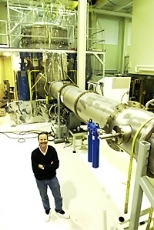The MIT team heading the search for gravitational waves reaching Earth from space expects to have some numbers early next month from its analysis of its observatory's first scientific run.
The Laser Interferometer Gravitational-Wave Observatory (LIGO), which is also the world's largest optical instrument, is expected to help scientists identify events in the universe not observable by any other means.
The U.S. interferometric gravitational wave detector system started scientific operations in late June with a two-week run. Researchers at MIT have been sifting through the mountains of resulting data.
"We don't expect to be able to see any events in this first data," said David H. Shoemaker, director of the LIGO Laboratory at the Center for Space Research. "But we should be able to develop a new upper limit and are optimistic that the initial instrument will make detections during its lifetime."
The LIGO team at MIT and its counterpart at Caltech are working on a second-generation instrument that is expected to be 15 times more sensitive and see a much larger volume of space at a time - more than 3,000 times more - than the initial instrument.
Albert Einstein, in his general theory of relativity, predicted that gravitational waves are faint ripples in the fabric of space-time believed to be produced by the gravitational effects of black holes, collisions and other violent events. They have never been directly observed.
The LIGO detectors in Livingston, La., and Hanford, Wash., are designed to detect these faint signals. Laser beams reflecting from mirrors inside the instruments may measure mirror displacements as small as one-thousandth of a proton's diameter.
The project is funded by the National Science Foundation and headed by a team from the California Institute of Technology and MIT.
For more information on LIGO, click here.
A version of this article appeared in MIT Tech Talk on October 30, 2002.






